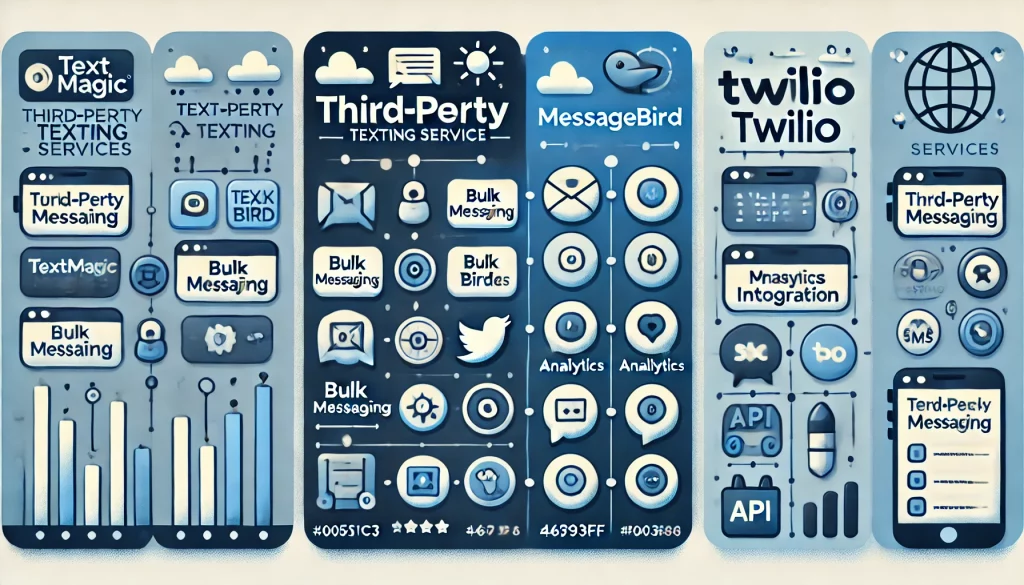Introduction
In today’s fast-paced world, being able to send a text message from an email account is incredibly convenient for both businesses and individuals. It allows you to keep all your communications in one place, making it easier to manage conversations without having to constantly switch between different platforms. This method is especially beneficial for businesses looking to improve their customer service and marketing strategies.
There are three main methods available for sending texts from an email account:
- Mobile Service Provider’s SMS Gateway
- Third-party Services
- Browser Extensions
Understanding these options will help you choose the most suitable approach for your needs.
Understanding Text Messaging Services
Text messaging services are essential for both personal and business communication, offering quick and direct ways to reach individuals. These services primarily involve two types of messages: SMS and MMS.
SMS (Short Message Service)
This is the most common form of text messaging. It allows users to send short text messages, usually limited to 160 characters. SMS is ideal for sending simple, straightforward messages without any multimedia content.
MMS (Multimedia Messaging Service)
This extends the capabilities of SMS by allowing users to send messages that include multimedia content such as images, videos, and rich text. Messages that exceed 160 characters or contain Unicode symbols often get converted into MMS automatically.
How Text Messaging Services Work
Text messaging services operate through a network of SMS gateways, which serve as intermediaries between email servers and mobile networks. Here’s how it works:
- Email Conversion: When you send an email to a recipient’s phone number via an SMS gateway, the gateway converts the email into a format compatible with SMS or MMS.
- Routing: The message is then routed through the mobile service provider’s network to deliver it to the recipient’s mobile device.
- Delivery: The recipient receives the message as a standard text message or multimedia message on their phone.
Understanding these basics helps you leverage text messaging services effectively, ensuring your communications are timely and appropriate for your audience.
Methods to Send Texts via Email

1. Mobile Service Provider’s SMS Gateway
An SMS gateway serves as a bridge between email systems and mobile networks. By converting emails into SMS or MMS, it enables sending text messages directly from an email account. This method is particularly convenient for both personal and business use.
How SMS Gateways Work
When you send an email to a mobile service provider’s SMS gateway, the email is translated into a text message and forwarded to the recipient’s phone number. The process involves:
- Addressing the Email: You need the recipient’s phone number and the service provider’s gateway address. For instance, if you’re sending a text to a Verizon user, you would send your email to [phonenumber]@vtext.com.
- Email Format: The subject line usually becomes the first line of the message, while the body of the email forms the main content.
- Character Limits: Standard SMS messages are limited to 160 characters. If your email exceeds this limit or includes multimedia content, it will be converted to an MMS.
Benefits of Using Mobile Service Provider’s SMS Gateway
- Simplicity: No third-party apps or extensions are needed. You can send texts directly from your existing email account.
- Cost Savings: Most providers offer this service for free or at a minimal cost, especially for small-scale usage.
- Centralized Communication: Emails and texts can be managed from one platform, streamlining communication efforts.
This method stands out for its straightforwardness and affordability. Businesses looking for easy integration without additional software will find this option particularly appealing.
2. Third-party Services for Texting

When you need to send text from email, third-party services offer versatile options tailored for both individuals and businesses. These services provide robust features that often surpass the capabilities of a standard mobile service provider’s SMS gateway.
Popular Third-party Services
- TextMagic
- Key Features: Bulk messaging, two-way communication, scheduling.
- Pricing: Approximately $0.04 per message.
- Message Media
- Key Features: API integration, delivery tracking, SMS replies.
- Pricing: Varies based on volume; typical costs are around $0.03-$0.05 per message.
- MessageBird
- Key Features: Omnichannel messaging (SMS, WhatsApp), analytics, global reach.
- Pricing: Starts at $0.01 per message but varies depending on the destination country.
- Twilio
- Key Features: Programmable SMS APIs, customization, high deliverability rates.
- Pricing: Generally around $0.0075 per message within the US.
Ease of Use vs Expense
- Ease of Use: These third-party services are designed with user-friendly interfaces and comprehensive documentation to simplify sending texts via email.
- Expense: While these platforms offer advanced functionalities and reliability, they come at a cost—typically ranging from $0.01 to $0.33 per message.
For businesses requiring extensive messaging capabilities or specialized features like APIs and analytics, investing in third-party services can be worthwhile despite the higher costs involved compared to using free text messaging options or a mobile service provider’s SMS gateway.
3. Browser Extensions for Texting via Email
Browser extensions offer another efficient way to send texts from an email account. These tools integrate directly with your web browser, allowing you to send SMS messages without switching platforms. This method is particularly useful if you frequently use your browser for communication and prefer a seamless experience.
Limitations:
- Most browser extensions are limited to sending messages to US and Canadian numbers.
- Free versions may have restrictions, such as a cap on the number of messages you can send per month.
Example: Textr’s Tool
Textr is a notable example of a browser extension that enables texting from email accounts. Some key features include:
- Local Numbers: Access to local numbers in 48 US states and 12 Canadian provinces.
- Free Messaging: Offers a limited number of free messages per month.
- Ease of Use: Simple installation process and user-friendly interface.
Using Textr, you can send SMS messages directly from your computer, enhancing convenience and eliminating the need for third-party services. This makes it an appealing option for both individuals and businesses looking for free text messaging options.
By integrating these capabilities into your browser, you streamline your communication processes and maintain centralized control over your messaging activities.
Comparison of SMS Gateways and Third-party Services
Pros and Cons of Using SMS Gateways
Pros:
- Simplicity: SMS gateways require no additional apps or extensions, making them straightforward to use.
- Cost-effective: Often free or low-cost, as they utilize existing mobile service providers.
- Direct Integration: Emails are directly converted to SMS/MMS by the gateway, ensuring seamless communication.
Cons:
- Limited Features: Basic functionality with minimal customization options.
- Dependence on Provider: Reliant on the mobile service provider’s gateway infrastructure, which may vary in reliability.
Pros and Cons of Using Third-party Services
Pros:
- Advanced Features: Offer comprehensive tools like scheduling, analytics, and bulk messaging.
- Scalability: Suitable for businesses with high-volume messaging needs.
- Global Reach: Many services support international texting beyond local providers’ coverage.
Cons:
- Expense: Costs can add up quickly, especially with pay-per-message models (e.g., $0.33 per message).
- Complexity: May require setup and integration efforts, including API configurations.
Considerations for Businesses
When choosing between these two options, businesses should weigh:
- Budget Constraints: Consider the long-term costs of third-party services versus the potential savings with SMS gateways.
- Feature Requirements: Assess whether advanced features like detailed analytics and bulk messaging are necessary.
- Scalability Needs: Determine if the business requires a solution that can grow with increasing messaging volumes.
- Reliability and Support: Evaluate the dependability of the service provider and the quality of customer support.
By carefully considering these factors, businesses can choose the most suitable method for their specific needs.
Using Textr for Sending SMS Messages Directly from Computer

The Textr tool is a reliable option for sending SMS messages directly from your computer. Unlike traditional methods, Textr eliminates the need for third-party services, offering a streamlined experience.
Key Features of Textr:
- No Third-party Services: By using Textr, you bypass the complications and costs associated with third-party texting services.
- Wide Coverage: Textr supports local numbers across 48 US states and 12 Canadian provinces, making it versatile for users in North America.
- Device Compatibility: Accessible on various devices, allowing you to send SMS messages from your browser seamlessly.
This tool ensures that your communication remains efficient and centralized without the hassle of additional software or extensions.
Conclusion
When deciding how to send a text message from an email account, it’s important to choose the method that best suits your needs and preferences.
- SMS Gateways offer simplicity and potential cost savings, making them an excellent choice for straightforward messaging needs.
- Third-party Services like TextMagic and Twilio provide robust features but can be more expensive.
- Browser Extensions such as Textr are convenient for sending messages directly from your computer, especially within the US and Canada.
Considering these options will help you find the most effective way to integrate texting into your communication strategy.
FAQs (Frequently Asked Questions)
What are the benefits of sending text messages from an email account?
Sending texts from an email account offers convenience and efficiency for both businesses and individuals. It allows users to communicate quickly without needing a mobile device, can save costs on SMS charges, and is particularly useful for sending bulk messages or notifications.
What is an SMS gateway and how does it work?
An SMS gateway is a service that converts emails into SMS or MMS messages. It acts as a bridge between your email account and mobile networks, allowing you to send text messages directly from your email interface. This method is simple and can offer cost savings compared to traditional texting methods.
What are some popular third-party services for sending texts via email?
Some popular third-party services include TextMagic, Message Media, MessageBird, and Twilio. These services provide various features such as easy integration with email accounts, different pricing models (e.g., $0.33 per message), and user-friendly interfaces, although they may come with higher costs than using an SMS gateway.
Can I use browser extensions to send texts from my email?
Yes, browser extensions like Textr allow users to send texts directly from their email accounts. However, there may be limitations such as only supporting US and Canadian phone numbers. Textr is noted for its ease of use and reliability in sending SMS messages.
How do I choose between using an SMS gateway or a third-party service?
When choosing between an SMS gateway and a third-party service, consider factors such as cost, ease of use, and the volume of messages you plan to send. Businesses should evaluate their specific needs, including whether they require additional features like tracking or analytics that some third-party services offer.
Is Textr a reliable option for sending SMS messages directly from my computer?
Yes, Textr is considered a reliable tool for sending SMS messages directly from your computer without relying on third-party services. It provides coverage across various US states and Canadian provinces, making it a practical choice for users looking to streamline their texting process.

